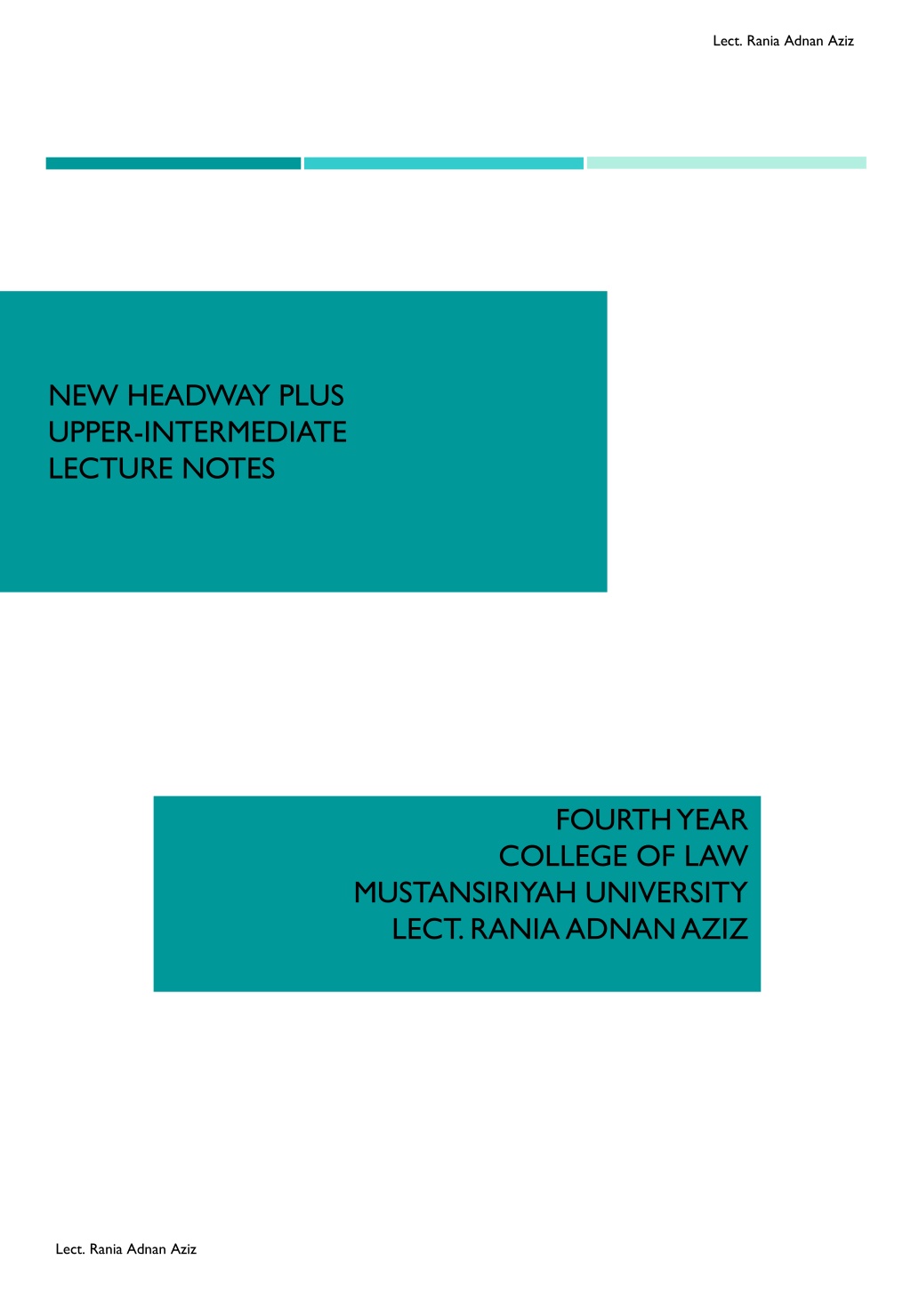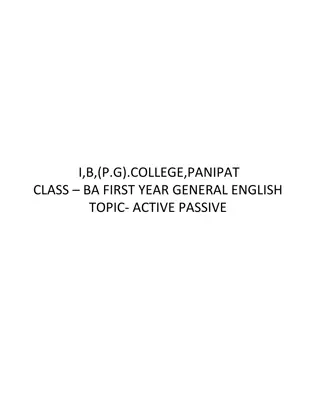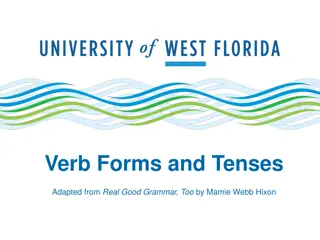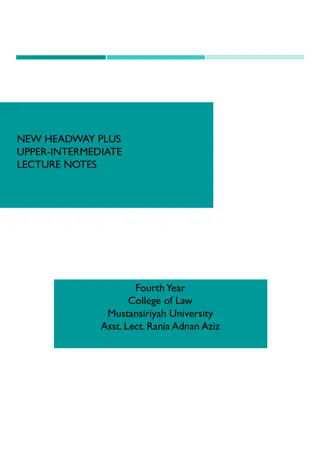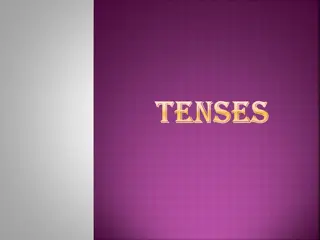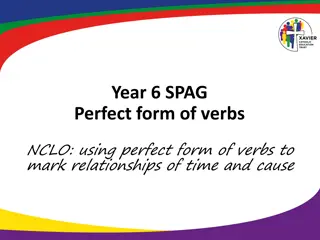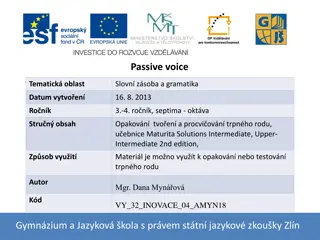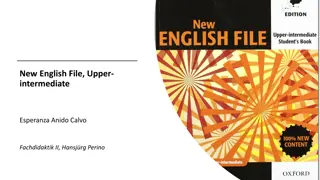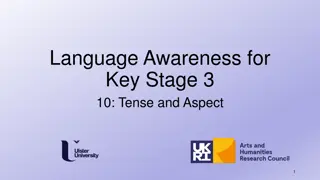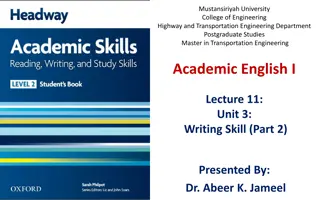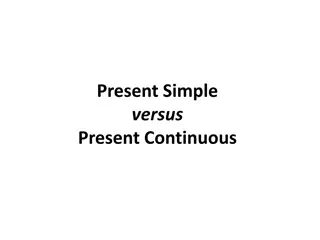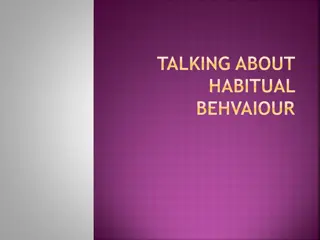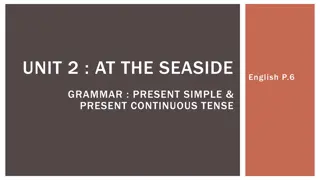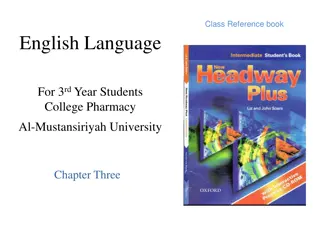Understanding Narrative Tenses: Past Simple, Present Perfect, and Past Continuous
Explore the nuances of narrative tenses through detailed lecture notes by Lecturer Rania Adnan Aziz. Learn the differences between Past Simple and Present Perfect, grasp the usage of Past Continuous, and understand the significance of Past Perfect in expressing past actions and timelines. Dive into examples and explanations to enhance your understanding of storytelling in English.
Download Presentation

Please find below an Image/Link to download the presentation.
The content on the website is provided AS IS for your information and personal use only. It may not be sold, licensed, or shared on other websites without obtaining consent from the author. Download presentation by click this link. If you encounter any issues during the download, it is possible that the publisher has removed the file from their server.
E N D
Presentation Transcript
Lect. Rania Adnan Aziz NEW HEADWAY PLUS UPPER-INTERMEDIATE LECTURE NOTES FOURTH YEAR COLLEGE OF LAW MUSTANSIRIYAH UNIVERSITY LECT. RANIA ADNAN AZIZ Lect. Rania Adnan Aziz
Lect. Rania Adnan Aziz Unit 3 What a story! Narrative Tenses PAST SIMPLEANDPRESENTPERFECT Past simple and present perfect both have connection with the past. The difference is that the past simple is rooted in the past and has no connection with the present, no present result, and the present perfect has a link with the present. PAST SIMPLE: Uses 1 3 5 A finished action in the past No present result Past state or habit 2 4 actions following each other Definite past Shakespeare wroteplays. (He s dead, so there is no more writing.) 1. I heard voices coming from downstairs, so I put on my dressing-gown and went to investigate. 2. I hurtmy back. (But it s better now.) 3. I saw him last night. 4. Compare this with the indefinite adverbials found with the Present Perfect. I ve seen him before. 5. When I was a child, we lived in a small house by the sea. Every day I walked for miles on the beach. This use is often expressed with used to. We used tolive I used towalk 2 Lect. Rania Adnan Aziz
Lect. Rania Adnan Aziz Unit 3 What a story! Narrative Tenses *Note: Even when there is no past time adverbial, we can build a past time in our head. Did you have a good journey? (The journey s over. You re here now.) PASTCONTINUOUS: Uses 1 5 To express activities in progress before, and probably after a particular time in the past To express an activity that was in progress at every moment during a period of time 4 2 To express an incomplete activity in the past To describe a past situation or activity 3 To express an interrupted past activity I phoned at 4:00, but there was no reply. What were you doing? 1. The cottage was looking so cozy. A fire was burning in the grate, music was playing and from the kitchen were coming the most delicious smells. 2. I was having a bath when the phone rang. 3. I wasreadinga book during the flight. (But I didn t finish it.) 4. Compare it with the past simple: I read a book during the flight. (the whole book) 5. I wasworking all day yesterday. 3 Lect. Rania Adnan Aziz
Lect. Rania Adnan Aziz Unit 3 What a story! Narrative Tenses *Note: The Past Simple expresses past actions as simple, complete facts. The past continuous gives past activities time and duration. What did you do last night? I stayed at home and watched the football. I phoned you last night, but there was no reply. Oh, I was watching the football and I didn t hear the phone. Sorry. PAST PERFECT The Past Perfect is used to make clear that one action in the past happened before another action in the past. She was crying because her grandmother had died. I arrived to pick up Dave, but he had already left. Notes: The continuous refers to longer actions or repeated activities. The simple refers to shorter, complete facts. He d lost his job and his flatmate had thrown him out. Since then he d been sleeping rough, and he hadn t been eating properly. The Past Perfect can refer to definite as well as indefinite time. I knew his face immediately. I d first met him in October 1993. (=definite) I recognized her face. I d seen her somewhere before. (=indefinite) 4 Lect. Rania Adnan Aziz
Lect. Rania Adnan Aziz Unit 3 What a story! Narrative Tenses PAST PERFECTAND PAST SIMPLE Verbs in the Past Simple tell a story in a chronological order. 1. John worked hard all day to prepare for the dinner. Everyone had a good time. Even the food was all right. Unfortunately, Andy upset Peter, so Peter left early. Pat came looking for Peter, but he wasn t there. It was a great evening. John sat and looked at all the mess. He felt tired. It was time for bed. By using the Past Perfect, the speaker or writer can tell a story in a different order. 2. John sat and looked at all the mess. It had been a great evening and everyone had had a good time. Even the food had been alright. Unfortunately, Andy upset Peter, so Peter left early. Pat came looking for Peter, but he d already gone. John felt tired. He d been working all day to prepare for the dinner. It was time for bed. 5 Lect. Rania Adnan Aziz
Lect. Rania Adnan Aziz Unit 3 What a story! Narrative Tenses TIMECLAUSES A conjunction is a word that connects two or more parts of a sentence. 1. We can use time conjunctions to talk about two actions that happen one after the other. Usually the Past Perfect is not necessary in these cases, although it can be used. As soon as the guests left/had left, I started tidying up. I sat outside until the sun had gone/went down. 2. The Past Perfect can help to make the first action seem separate, independent of the second, or completed before the second action started. We stayed up until all the guests had gone. 3. Two verbs in the Past Simple can suggest that the first action led into the other, or that one caused the other to happen. As soon as the alarm went off, I got up. 4. The Past Perfect is more common with when because it is ambiguous. The other conjunctions are more specific, so the Past Perfect is not so essential. As soon as all the guests left, I tidied the house. Before I met you, I didn't know the meaning of kindness. When I opened the door, the cat jumped out. When I'd opened the mail, I made another cup of tea. 6 Lect. Rania Adnan Aziz
